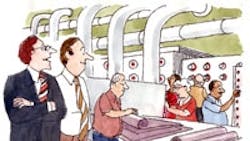It's expected that the aging workforce will cause some aches and pains for manufacturers as the baby boomers retire and leave the plant floor without skilled replacements. But manufacturers already are experiencing symptoms of a maturing operations staff.
"There's a question of, 'If we have people who stay longer in the workplace, how are we going to accommodate them physically?'" says Brian Sherman, director of ergonomic services, The Ergonomics Center of North Carolina at North Carolina State University.
Some manufacturers are addressing their workers' decreasing physical capabilities by offering modified work programs. Sherman cites mailing equipment maker Pitney Bowes Inc. as an example of a company that provides a flexible work plan to reduce stress on older employees. The company, a 2004 winner of AARP's Best Employers For Workers Over 50 award, has a phased-in retirement program where employees nearing retirement can work partial days. Sherman also refers to "snowbird" programs companies have implemented that allow employees who migrate to warmer climates in the winter to return in the spring.
"I'll tell you a secret: Ever since we hired an over-50's crew, our production has doubled."
Typically, new ergonomics programs will focus on such reactive solutions as work rotation and cell reconfigurations, Sherman says. But truly mature programs target the actual manufacturing process of products. In the automotive industry, for instance, when launching a new vehicle many automakers will conduct packaging reviews to determine production sequencing and accessibility. "It has nothing to do with customer service," Sherman says. "It all has to do with how we put it together. That's a sign of a mature program -- you're influencing the product in its assembly."
See Also
About the Author
Jonathan Katz
Former Managing Editor
Former Managing Editor Jon Katz covered leadership and strategy, tackling subjects such as lean manufacturing leadership, strategy development and deployment, corporate culture, corporate social responsibility, and growth strategies. As well, he provided news and analysis of successful companies in the chemical and energy industries, including oil and gas, renewable and alternative.
Jon worked as an intern for IndustryWeek before serving as a reporter for The Morning Journal and then as an associate editor for Penton Media’s Supply Chain Technology News.
Jon received his bachelor’s degree in Journalism from Kent State University and is a die-hard Cleveland sports fan.
